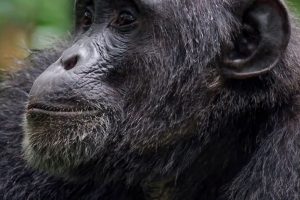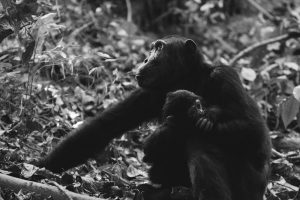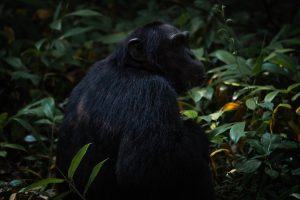Chimpanzee trekking is among the top activities that attract tourists to Africa. This activity is done in dense tropical forests in Uganda, Rwanda, Tanzania, and the Democratic Republic of Congo. High success rates are achieved with guidance from a local expert tracker, trained guides, and an armed ranger. Trackers witness how these uniquely social primates interact with one another. These primates are highly social, intelligent, and communicative. They travel, sleep, and feed in subgroups as members of the groups change regularly. They have hierarchies usually led by a dominant male.
In all primates, chimpanzees are the closest cousins to human beings. As we share 98% of DNA, Chimps live up to 40 – 60 years. Males weigh between 90 and 130 lbs while females tend to be slightly smaller. They usually weigh between 60 and 100 lbs. Additionally, Chimps live in family groups called troops ranging from 15 to 20 members. However, a group can be bigger to almost 100 members. Each community (band) has a unique personality.



In Uganda, about 5,500 Chimps live in dense forests leading to a higher success rate than anywhere else. Travelers need a permit to engage in chimpanzee trekking which is acquired from the Uganda Wildlife Authority. Trekking chimps can be done at the following;
Kibale National Park is the world’s top destination for chimpanzee trekking. Approximately 1,500 chimpanzees live in this park but only habituated chimps can be visited. With this population, tourists have a high chance of being able to see chimps. The Park is located in the Southwestern part of the country. It has 3habituated groups one for tourism and two for research purposes. Tracking chimps is done every day from 7 am and another shift starts at 2 pm to evening hours. Tourists need a permit to participate in this activity and these are obtained from the Uganda Wildlife Authority (UWA).
Kyambura Gorge is also another place to have the trekking experience. It is located in the Northeastern corner of Queen Elizabeth National Park and was created as a buffer zone to avoid human encroachment. This area is home to 27 chimpanzees and several other primates including the vervet monkeys, baboons, and birds. This makes it a great place to explore as you traverse into the dense undergrowth to get a closer look at the chimpanzees.
Budongo Forest Reserve is near Murchison Falls National Park. It has habituated groups in the Kaniyo Pabidi section of the forest that can be visited. This is home to around 800 chimps making it a better destination to trek these great primates for tourism and conservation purposes.
Bugoma Forest is a tropical rainforest that is home to about 500 chimpanzees. These make up 10% of the Ugandan chimp population, together with other primates. These include black and white colobus monkeys, reptiles, Uganda Mangabey monkeys, red-tailed monkeys, blue monkeys, golden cats (profiles aurata), and side-stripped jackals. A small number of bush elephants have been recorded in recent years. The forest is an ideal destination for chimpanzee trekking, located in Western Uganda. Situated on the southwestern side of Hoima District, the Northeastern side of Kyenjojo Town, and the eastern side of Lake Albert.
Kalinzu Forest Reserve is home to around 320 chimps and is home to one of the largest families of chimpanzees in Uganda. It is located in Bushenyi District near Queen Elizabeth National Park. The reserve is home to other primate species like baboons, blue monkeys, red-tailed monkeys, l’hoest monkeys, vervet monkeys, and black and white colobus monkeys. Communication here is by radio where Uganda wildlife rangers communicate where the chimpanzees have been spotted or slept the day before. Once you have located the chimpanzees, you follow them while they go about their daily lives. Chimps move fast, a certain degree of fitness here is needed to keep up with their movements.
The Uganda wildlife education center formerly known as Entebbe Zoo is one place to see chimpanzees. It was established around 1952 with an aim of rehabilitating endangered wild animals. Visitors who are unable to visit the parks can get to see these endangered animals and other primates at this center.
Ngamba Island is a small forested island located on Lake Victoria which was made for rescued endangered chimpanzees’ country-wide. The sanctuary is home to over 50 orphaned chimpanzees rescued from across East Africa. It was not intended for chimpanzee trekking instead, visitors to the island get to watch the chimpanzees. They are in a protected elevated platform and can be seen every time they come to feed. Their feeding takes place three times a day.
Chimpanzee trekking permits in Uganda are as follows. Kibale Forest National Park a permit costs $250 per person for foreign non-residents, $200 for foreign residents, and 180,000 Ugandan Shillings per person for East African citizens. Budongo Forest, a chimpanzee trekking permit costs 180 USD for foreign non-residents, 170 USD for foreign residents, and 135 USD for East African citizens.
Kalinzu Forest and Kyambura Gorge, a chimpanzee trekking permit costs 100 USD per person for foreign non-residents, 80 USD per person for foreign residents, and 50,000 ugx per person for East African citizens. Whereas chimpanzee trekking permits at Nyungwe Forest National Park cost Usd150 per person for foreign non-residents. Foreign residents pay 75 US Dollars per person and $25 per person for East African citizens.
Chimpanzee trekking can be done at any time of the year in Uganda, however, the best time to go is during the dry season. Uganda has got two main seasons, the wet season and the dry season. The short dry season occurs from October- November while the long wet season occurs from March, April, and May. The long dry season is from June, July, August, and September and the short dry season is from December to February.
During the dry seasons, it is easier to trek the chimpanzees since there is little or no rainfall. During such a period, the forests are not thick while the trekking trails are not muddy and slippery making it easy to see chimpanzees. The dry season is also favorable for visiting other national parks for wildlife viewing. However, this season is competitive for permits, and lodging facilities do not offer discounts since the parks are having many tourists.
The wet season of March to May and October to November might not be the best time for chimpanzee trekking but it is possible to trek chimps during this season. However, it is difficult and hectic since most trails are slippery and muddy. But the beauty about it is the chimpanzee will be easily seen since the forests have plenty of food to feed. Accommodation facilities tend to offer discounts during this season. The permits for trekking have less competition and many birds to see. If you are planning to combine chimpanzee trekking and chimpanzee habituation, then you should plan to visit in April, May, and October. That is the period when chimpanzee habituation takes place at Kibale Forest National Park in Uganda.
Protecting your body while trekking chimps in the tropical forest should be one of your number one motives. Here is a list of some of the essentials to pack for your trekking tour.
Chimpanzee trekking is one of the most popular activities done in Rwanda and can be done in two national parks. These include Nyungwe National Park and Gishwati Mukura National Park. Nyungwe National Park is one of the top destinations where tourists go for chimpanzee treks, especially in Cyamudongo Forest which is adjacent to the park. These primates spend the majority of their time climbing trees and moving around from time to time.
The activity begins early at 5:00 am with a briefing by the park’s head ranger about what guidelines should be followed while trekking through the park to ensure safety for both humans and chimps. Visitors are then divided into different groups of almost eight members and the group treks a habituated group. One habituated chimpanzee community lives in Cyamudongo forest, a small patch of forest located to the east of Nyungwe forest. It is detached from the main forest.
The second habituated chimpanzee group is found in the main Nyungwe forest around the Uwinka area (park headquarters) and is bigger with about 60 chimps. However, given the terrain, it sometimes offers lesser chances of seeing the chimps, compared to the chimp group in the Cyamudongo forest. The three chimpanzee trekking centers in the park are Kitabi, Gisakura, and Uwinka from where trekking starts.
While carrying out chimpanzee trekking, you go deep into the forest while identifying the various troops. This takes you like probably 30 minutes or one hour to reach the chimpanzees. After getting them the tourists are given one hour to be with the chimpanzees while enjoying their presence as you are observing their characters, behaviors, and others. Trekking in Nyungwe National Park is only done by individuals above 15 years of age.
Tanzania is known to have the highest number of chimpanzees and this country is the most visited safari destination in Africa. Chimpanzees are in many of the national parks in the country, but most of the trekkers frequent the Gombe National Park and Mahale Mountain National Park.
The park is located on the slopes of Mahale Mountains and was gazetted in 1985 to be a permanent home for the now 800 Chimpanzees in the area covering 1,613 sq. Km. It consists of habitats that include rainforest, grasslands, bamboo, and woodlands. The park is also home to 50 species of animals.
Gombe National Park is one of the smallest parks in Tanzania and a well-known destination for chimpanzee trekking. It is comprised of a thin strip of ancient forest along the steep slopes and river valleys that surround the northern shore of Lake Tanganyika. The British primate researcher Jane Goodall did her research and studies on the endangered chimpanzees, as well as their behavioral characteristics in Gombe National Park.
The park is generally comprised of primates, not only Chimpanzees but also olive baboons, vervet monkeys, red-tailed and red colobus monkeys among others. Trekking is done with trained trackers and guides who locate the chimps. Travelers are allowed to spend only one hour observing them as they feed, groom each other, make nests, and many more.
